Lego's Marketing Strategy: A Comprehensive Analysis of Product Mix
VerifiedAdded on 2023/05/29
|7
|1239
|130
Report
AI Summary
This report provides an overview of Lego's marketing strategy, focusing on its product strategy and marketing mix. It examines Lego's product life cycle, from introduction to decline and its subsequent reinvention. The analysis covers Lego's differentiation strategy, brand equity, and various product lines, including Lego sets, Mindstorms, board games, and clothing. The report highlights Lego's ability to adapt and innovate, enabling it to maintain a strong market position. Desklib provides similar solved assignments and resources for students.
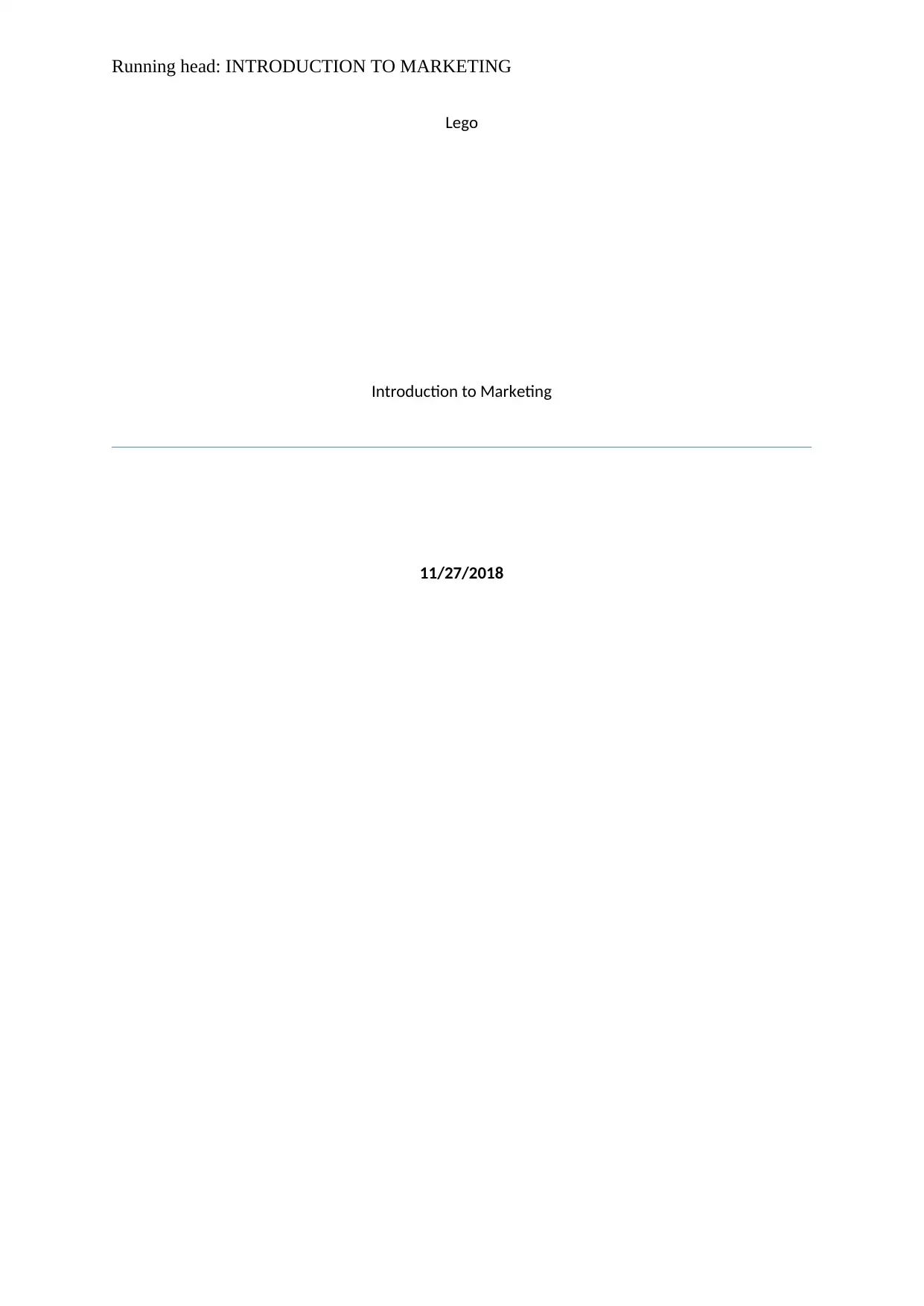
Running head: INTRODUCTION TO MARKETING
Lego
Introduction to Marketing
11/27/2018
Lego
Introduction to Marketing
11/27/2018
Paraphrase This Document
Need a fresh take? Get an instant paraphrase of this document with our AI Paraphraser
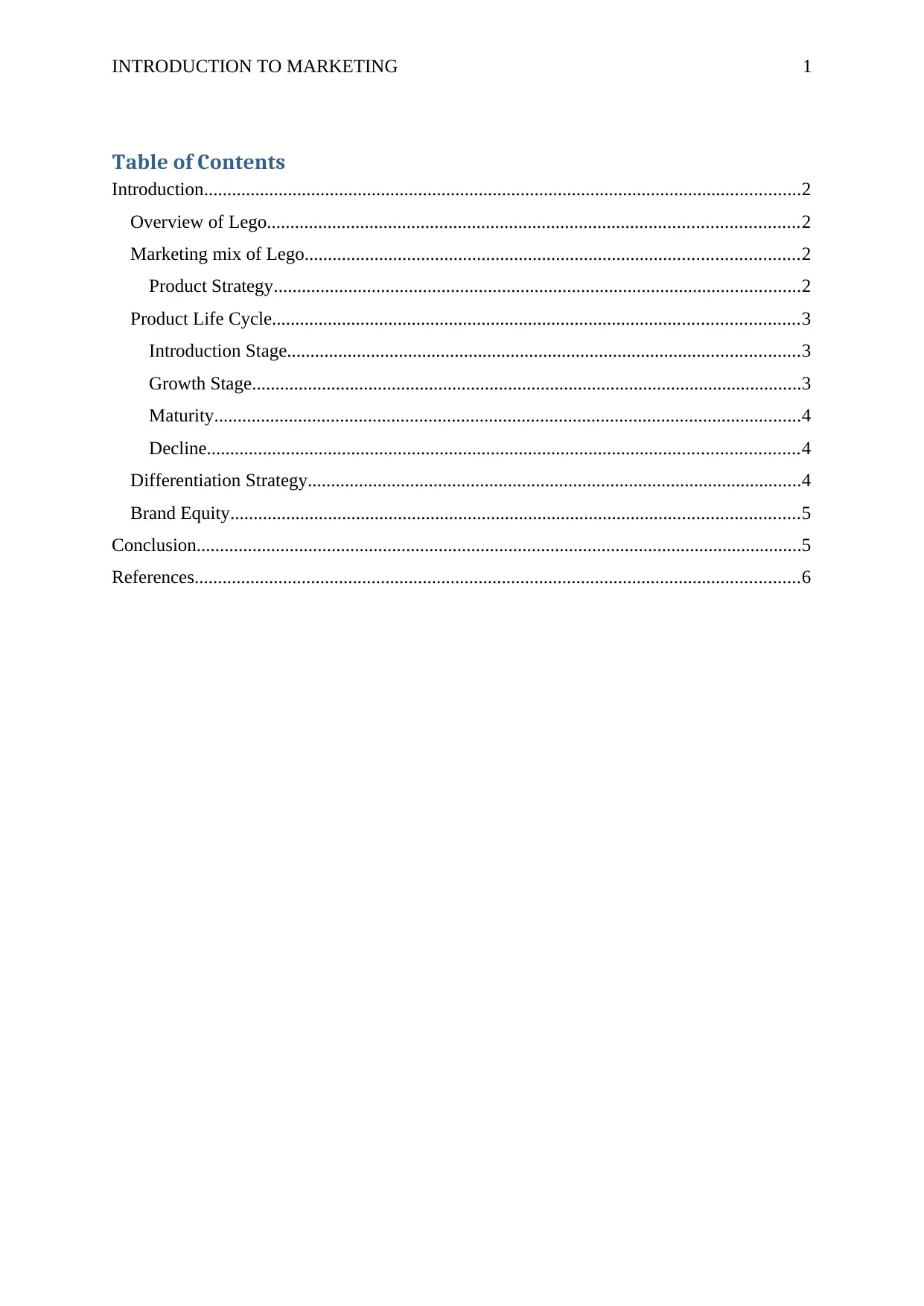
INTRODUCTION TO MARKETING 1
Table of Contents
Introduction................................................................................................................................2
Overview of Lego..................................................................................................................2
Marketing mix of Lego..........................................................................................................2
Product Strategy.................................................................................................................2
Product Life Cycle.................................................................................................................3
Introduction Stage..............................................................................................................3
Growth Stage......................................................................................................................3
Maturity..............................................................................................................................4
Decline...............................................................................................................................4
Differentiation Strategy..........................................................................................................4
Brand Equity..........................................................................................................................5
Conclusion..................................................................................................................................5
References..................................................................................................................................6
Table of Contents
Introduction................................................................................................................................2
Overview of Lego..................................................................................................................2
Marketing mix of Lego..........................................................................................................2
Product Strategy.................................................................................................................2
Product Life Cycle.................................................................................................................3
Introduction Stage..............................................................................................................3
Growth Stage......................................................................................................................3
Maturity..............................................................................................................................4
Decline...............................................................................................................................4
Differentiation Strategy..........................................................................................................4
Brand Equity..........................................................................................................................5
Conclusion..................................................................................................................................5
References..................................................................................................................................6
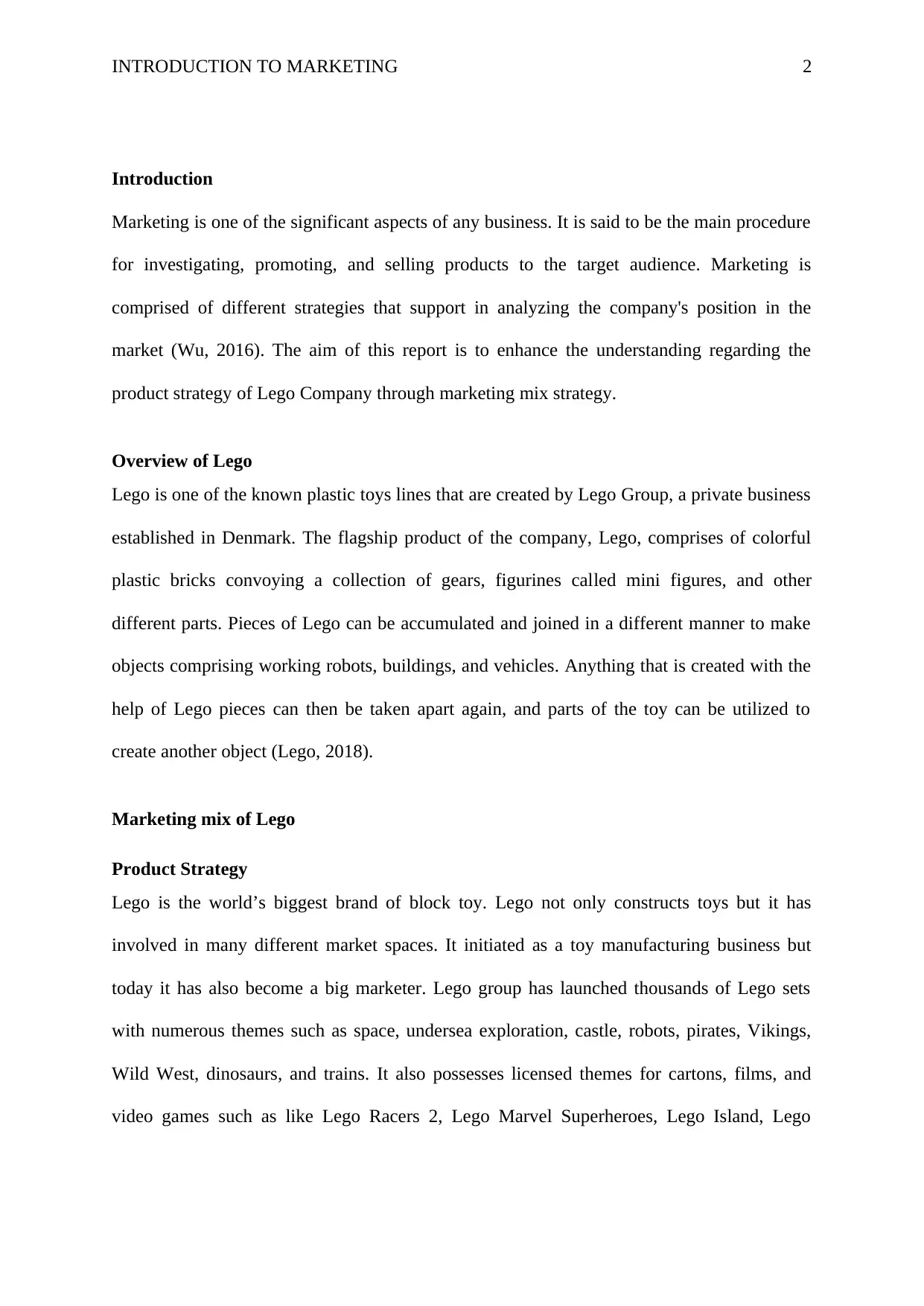
INTRODUCTION TO MARKETING 2
Introduction
Marketing is one of the significant aspects of any business. It is said to be the main procedure
for investigating, promoting, and selling products to the target audience. Marketing is
comprised of different strategies that support in analyzing the company's position in the
market (Wu, 2016). The aim of this report is to enhance the understanding regarding the
product strategy of Lego Company through marketing mix strategy.
Overview of Lego
Lego is one of the known plastic toys lines that are created by Lego Group, a private business
established in Denmark. The flagship product of the company, Lego, comprises of colorful
plastic bricks convoying a collection of gears, figurines called mini figures, and other
different parts. Pieces of Lego can be accumulated and joined in a different manner to make
objects comprising working robots, buildings, and vehicles. Anything that is created with the
help of Lego pieces can then be taken apart again, and parts of the toy can be utilized to
create another object (Lego, 2018).
Marketing mix of Lego
Product Strategy
Lego is the world’s biggest brand of block toy. Lego not only constructs toys but it has
involved in many different market spaces. It initiated as a toy manufacturing business but
today it has also become a big marketer. Lego group has launched thousands of Lego sets
with numerous themes such as space, undersea exploration, castle, robots, pirates, Vikings,
Wild West, dinosaurs, and trains. It also possesses licensed themes for cartons, films, and
video games such as like Lego Racers 2, Lego Marvel Superheroes, Lego Island, Lego
Introduction
Marketing is one of the significant aspects of any business. It is said to be the main procedure
for investigating, promoting, and selling products to the target audience. Marketing is
comprised of different strategies that support in analyzing the company's position in the
market (Wu, 2016). The aim of this report is to enhance the understanding regarding the
product strategy of Lego Company through marketing mix strategy.
Overview of Lego
Lego is one of the known plastic toys lines that are created by Lego Group, a private business
established in Denmark. The flagship product of the company, Lego, comprises of colorful
plastic bricks convoying a collection of gears, figurines called mini figures, and other
different parts. Pieces of Lego can be accumulated and joined in a different manner to make
objects comprising working robots, buildings, and vehicles. Anything that is created with the
help of Lego pieces can then be taken apart again, and parts of the toy can be utilized to
create another object (Lego, 2018).
Marketing mix of Lego
Product Strategy
Lego is the world’s biggest brand of block toy. Lego not only constructs toys but it has
involved in many different market spaces. It initiated as a toy manufacturing business but
today it has also become a big marketer. Lego group has launched thousands of Lego sets
with numerous themes such as space, undersea exploration, castle, robots, pirates, Vikings,
Wild West, dinosaurs, and trains. It also possesses licensed themes for cartons, films, and
video games such as like Lego Racers 2, Lego Marvel Superheroes, Lego Island, Lego
⊘ This is a preview!⊘
Do you want full access?
Subscribe today to unlock all pages.

Trusted by 1+ million students worldwide
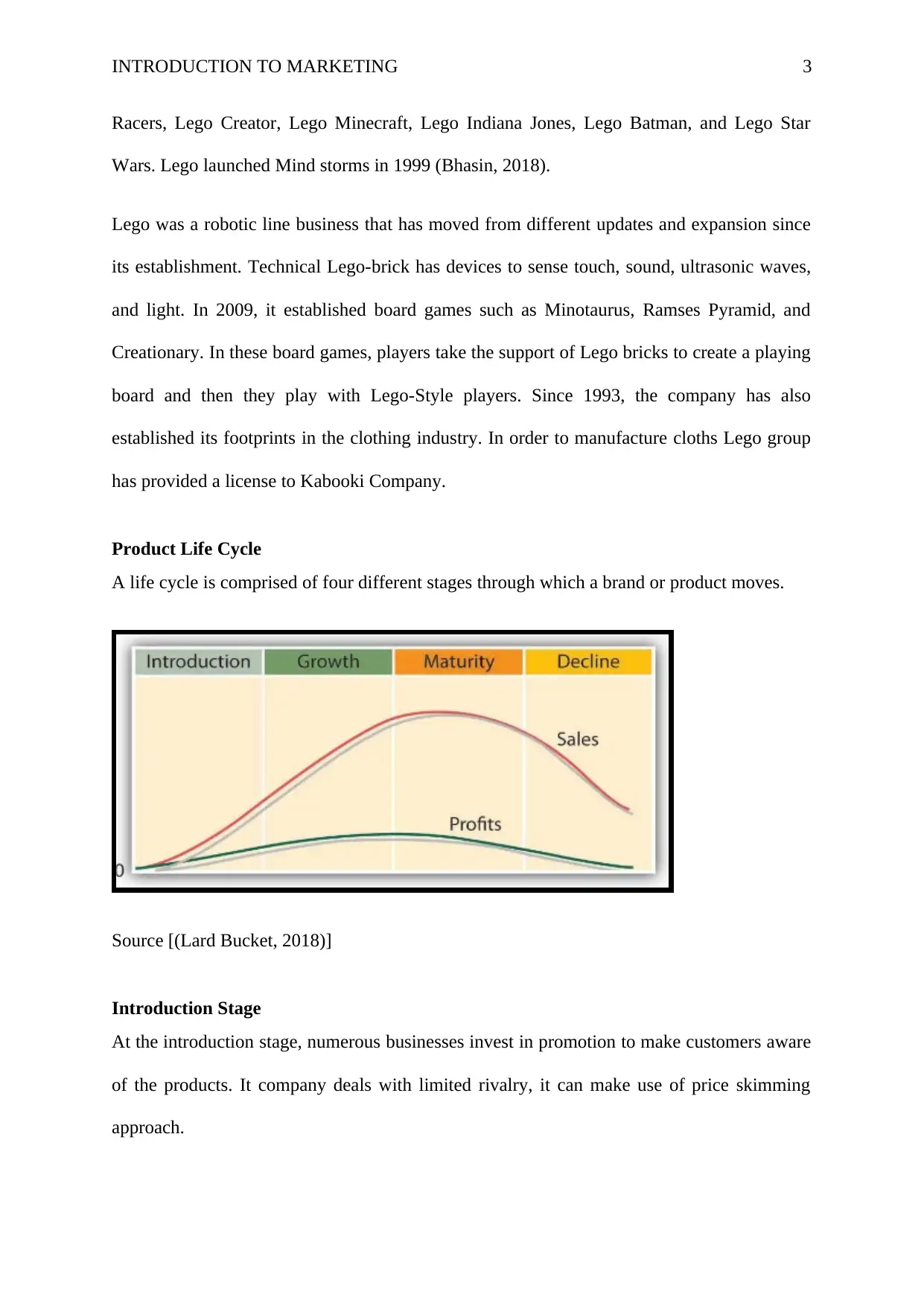
INTRODUCTION TO MARKETING 3
Racers, Lego Creator, Lego Minecraft, Lego Indiana Jones, Lego Batman, and Lego Star
Wars. Lego launched Mind storms in 1999 (Bhasin, 2018).
Lego was a robotic line business that has moved from different updates and expansion since
its establishment. Technical Lego-brick has devices to sense touch, sound, ultrasonic waves,
and light. In 2009, it established board games such as Minotaurus, Ramses Pyramid, and
Creationary. In these board games, players take the support of Lego bricks to create a playing
board and then they play with Lego-Style players. Since 1993, the company has also
established its footprints in the clothing industry. In order to manufacture cloths Lego group
has provided a license to Kabooki Company.
Product Life Cycle
A life cycle is comprised of four different stages through which a brand or product moves.
Source [(Lard Bucket, 2018)]
Introduction Stage
At the introduction stage, numerous businesses invest in promotion to make customers aware
of the products. It company deals with limited rivalry, it can make use of price skimming
approach.
Racers, Lego Creator, Lego Minecraft, Lego Indiana Jones, Lego Batman, and Lego Star
Wars. Lego launched Mind storms in 1999 (Bhasin, 2018).
Lego was a robotic line business that has moved from different updates and expansion since
its establishment. Technical Lego-brick has devices to sense touch, sound, ultrasonic waves,
and light. In 2009, it established board games such as Minotaurus, Ramses Pyramid, and
Creationary. In these board games, players take the support of Lego bricks to create a playing
board and then they play with Lego-Style players. Since 1993, the company has also
established its footprints in the clothing industry. In order to manufacture cloths Lego group
has provided a license to Kabooki Company.
Product Life Cycle
A life cycle is comprised of four different stages through which a brand or product moves.
Source [(Lard Bucket, 2018)]
Introduction Stage
At the introduction stage, numerous businesses invest in promotion to make customers aware
of the products. It company deals with limited rivalry, it can make use of price skimming
approach.
Paraphrase This Document
Need a fresh take? Get an instant paraphrase of this document with our AI Paraphraser
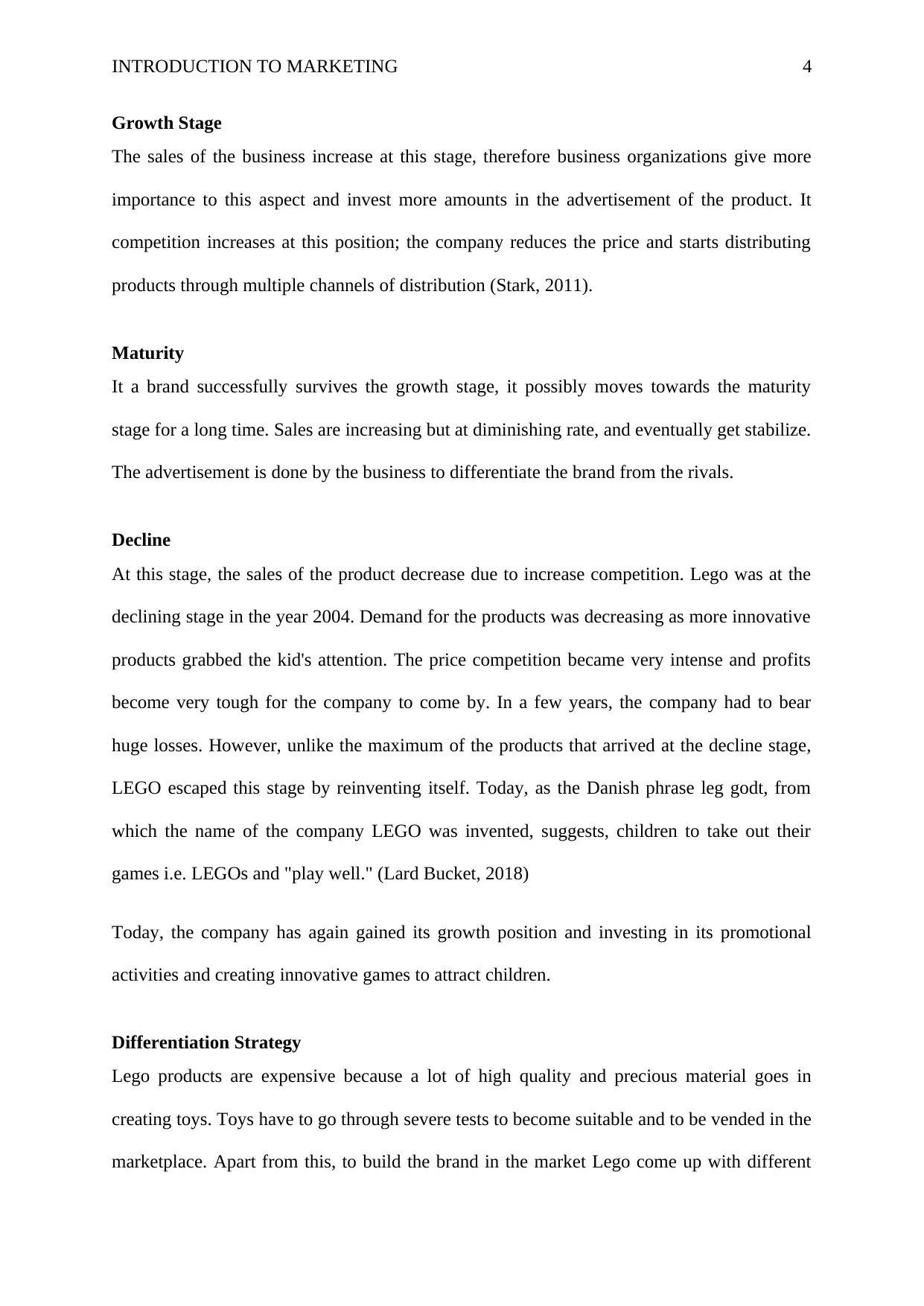
INTRODUCTION TO MARKETING 4
Growth Stage
The sales of the business increase at this stage, therefore business organizations give more
importance to this aspect and invest more amounts in the advertisement of the product. It
competition increases at this position; the company reduces the price and starts distributing
products through multiple channels of distribution (Stark, 2011).
Maturity
It a brand successfully survives the growth stage, it possibly moves towards the maturity
stage for a long time. Sales are increasing but at diminishing rate, and eventually get stabilize.
The advertisement is done by the business to differentiate the brand from the rivals.
Decline
At this stage, the sales of the product decrease due to increase competition. Lego was at the
declining stage in the year 2004. Demand for the products was decreasing as more innovative
products grabbed the kid's attention. The price competition became very intense and profits
become very tough for the company to come by. In a few years, the company had to bear
huge losses. However, unlike the maximum of the products that arrived at the decline stage,
LEGO escaped this stage by reinventing itself. Today, as the Danish phrase leg godt, from
which the name of the company LEGO was invented, suggests, children to take out their
games i.e. LEGOs and "play well." (Lard Bucket, 2018)
Today, the company has again gained its growth position and investing in its promotional
activities and creating innovative games to attract children.
Differentiation Strategy
Lego products are expensive because a lot of high quality and precious material goes in
creating toys. Toys have to go through severe tests to become suitable and to be vended in the
marketplace. Apart from this, to build the brand in the market Lego come up with different
Growth Stage
The sales of the business increase at this stage, therefore business organizations give more
importance to this aspect and invest more amounts in the advertisement of the product. It
competition increases at this position; the company reduces the price and starts distributing
products through multiple channels of distribution (Stark, 2011).
Maturity
It a brand successfully survives the growth stage, it possibly moves towards the maturity
stage for a long time. Sales are increasing but at diminishing rate, and eventually get stabilize.
The advertisement is done by the business to differentiate the brand from the rivals.
Decline
At this stage, the sales of the product decrease due to increase competition. Lego was at the
declining stage in the year 2004. Demand for the products was decreasing as more innovative
products grabbed the kid's attention. The price competition became very intense and profits
become very tough for the company to come by. In a few years, the company had to bear
huge losses. However, unlike the maximum of the products that arrived at the decline stage,
LEGO escaped this stage by reinventing itself. Today, as the Danish phrase leg godt, from
which the name of the company LEGO was invented, suggests, children to take out their
games i.e. LEGOs and "play well." (Lard Bucket, 2018)
Today, the company has again gained its growth position and investing in its promotional
activities and creating innovative games to attract children.
Differentiation Strategy
Lego products are expensive because a lot of high quality and precious material goes in
creating toys. Toys have to go through severe tests to become suitable and to be vended in the
marketplace. Apart from this, to build the brand in the market Lego come up with different
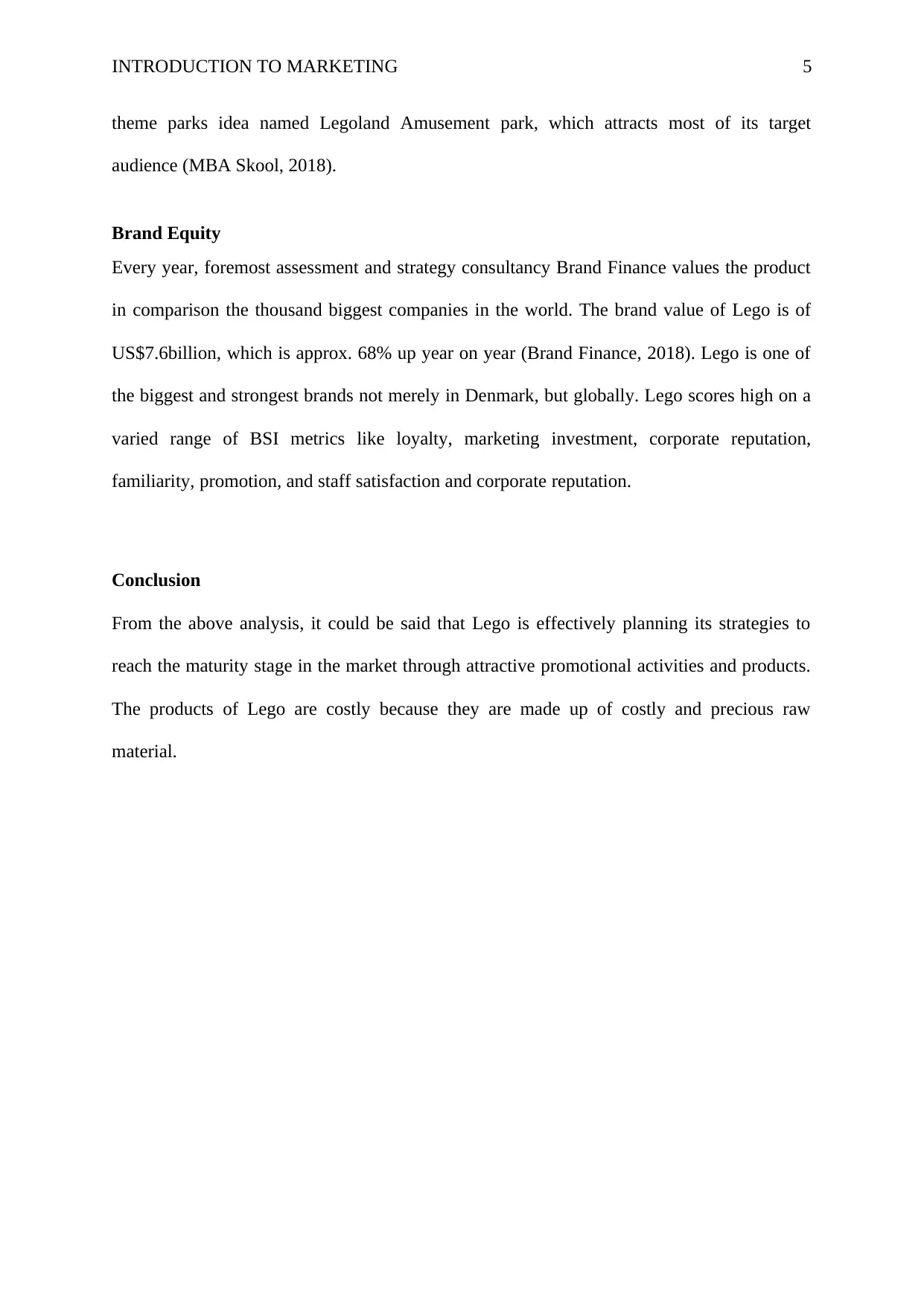
INTRODUCTION TO MARKETING 5
theme parks idea named Legoland Amusement park, which attracts most of its target
audience (MBA Skool, 2018).
Brand Equity
Every year, foremost assessment and strategy consultancy Brand Finance values the product
in comparison the thousand biggest companies in the world. The brand value of Lego is of
US$7.6billion, which is approx. 68% up year on year (Brand Finance, 2018). Lego is one of
the biggest and strongest brands not merely in Denmark, but globally. Lego scores high on a
varied range of BSI metrics like loyalty, marketing investment, corporate reputation,
familiarity, promotion, and staff satisfaction and corporate reputation.
Conclusion
From the above analysis, it could be said that Lego is effectively planning its strategies to
reach the maturity stage in the market through attractive promotional activities and products.
The products of Lego are costly because they are made up of costly and precious raw
material.
theme parks idea named Legoland Amusement park, which attracts most of its target
audience (MBA Skool, 2018).
Brand Equity
Every year, foremost assessment and strategy consultancy Brand Finance values the product
in comparison the thousand biggest companies in the world. The brand value of Lego is of
US$7.6billion, which is approx. 68% up year on year (Brand Finance, 2018). Lego is one of
the biggest and strongest brands not merely in Denmark, but globally. Lego scores high on a
varied range of BSI metrics like loyalty, marketing investment, corporate reputation,
familiarity, promotion, and staff satisfaction and corporate reputation.
Conclusion
From the above analysis, it could be said that Lego is effectively planning its strategies to
reach the maturity stage in the market through attractive promotional activities and products.
The products of Lego are costly because they are made up of costly and precious raw
material.
⊘ This is a preview!⊘
Do you want full access?
Subscribe today to unlock all pages.

Trusted by 1+ million students worldwide
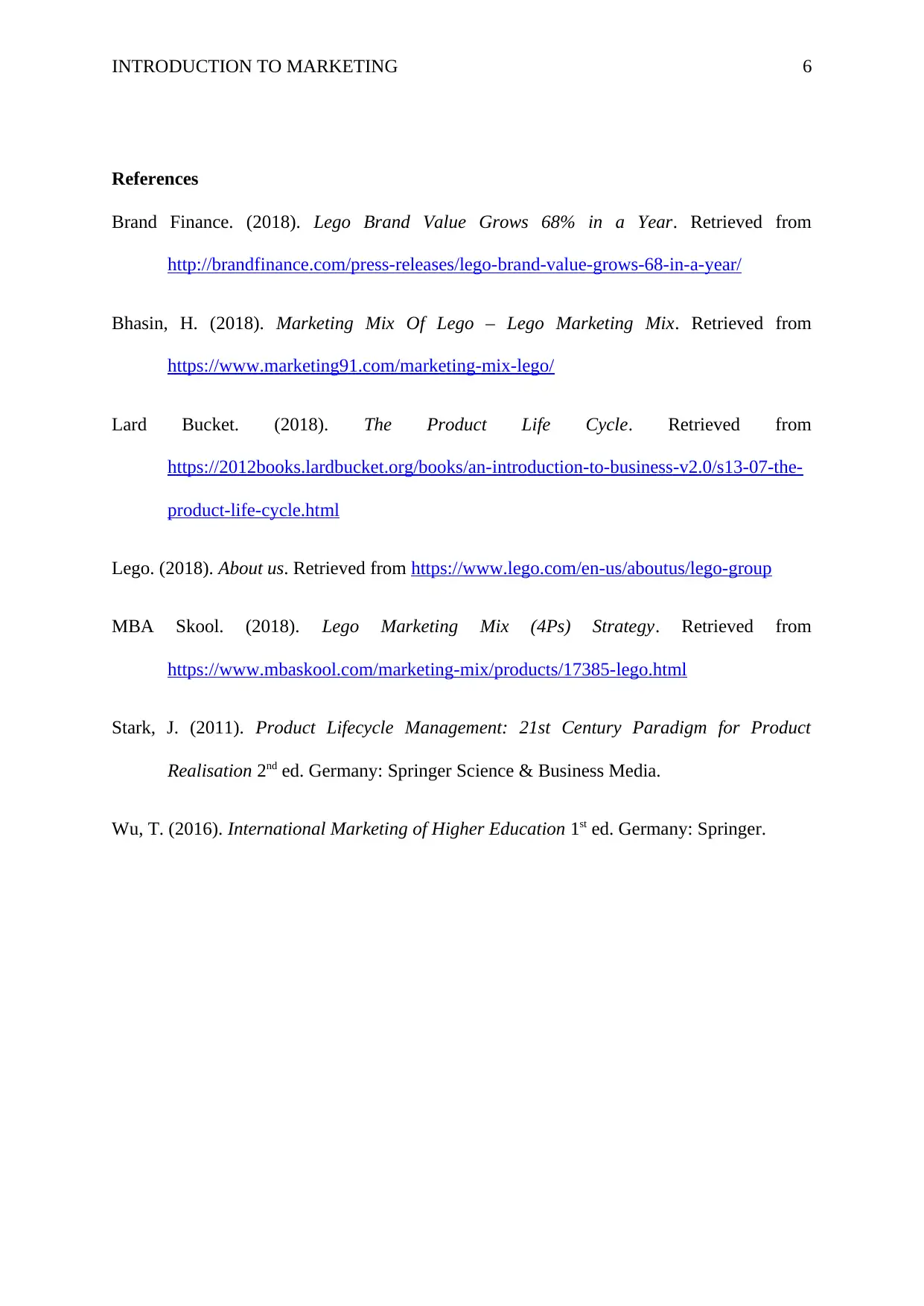
INTRODUCTION TO MARKETING 6
References
Brand Finance. (2018). Lego Brand Value Grows 68% in a Year. Retrieved from
http://brandfinance.com/press-releases/lego-brand-value-grows-68-in-a-year/
Bhasin, H. (2018). Marketing Mix Of Lego – Lego Marketing Mix. Retrieved from
https://www.marketing91.com/marketing-mix-lego/
Lard Bucket. (2018). The Product Life Cycle. Retrieved from
https://2012books.lardbucket.org/books/an-introduction-to-business-v2.0/s13-07-the-
product-life-cycle.html
Lego. (2018). About us. Retrieved from https://www.lego.com/en-us/aboutus/lego-group
MBA Skool. (2018). Lego Marketing Mix (4Ps) Strategy. Retrieved from
https://www.mbaskool.com/marketing-mix/products/17385-lego.html
Stark, J. (2011). Product Lifecycle Management: 21st Century Paradigm for Product
Realisation 2nd ed. Germany: Springer Science & Business Media.
Wu, T. (2016). International Marketing of Higher Education 1st ed. Germany: Springer.
References
Brand Finance. (2018). Lego Brand Value Grows 68% in a Year. Retrieved from
http://brandfinance.com/press-releases/lego-brand-value-grows-68-in-a-year/
Bhasin, H. (2018). Marketing Mix Of Lego – Lego Marketing Mix. Retrieved from
https://www.marketing91.com/marketing-mix-lego/
Lard Bucket. (2018). The Product Life Cycle. Retrieved from
https://2012books.lardbucket.org/books/an-introduction-to-business-v2.0/s13-07-the-
product-life-cycle.html
Lego. (2018). About us. Retrieved from https://www.lego.com/en-us/aboutus/lego-group
MBA Skool. (2018). Lego Marketing Mix (4Ps) Strategy. Retrieved from
https://www.mbaskool.com/marketing-mix/products/17385-lego.html
Stark, J. (2011). Product Lifecycle Management: 21st Century Paradigm for Product
Realisation 2nd ed. Germany: Springer Science & Business Media.
Wu, T. (2016). International Marketing of Higher Education 1st ed. Germany: Springer.
1 out of 7
Related Documents
Your All-in-One AI-Powered Toolkit for Academic Success.
+13062052269
info@desklib.com
Available 24*7 on WhatsApp / Email
![[object Object]](/_next/static/media/star-bottom.7253800d.svg)
Unlock your academic potential
Copyright © 2020–2025 A2Z Services. All Rights Reserved. Developed and managed by ZUCOL.





